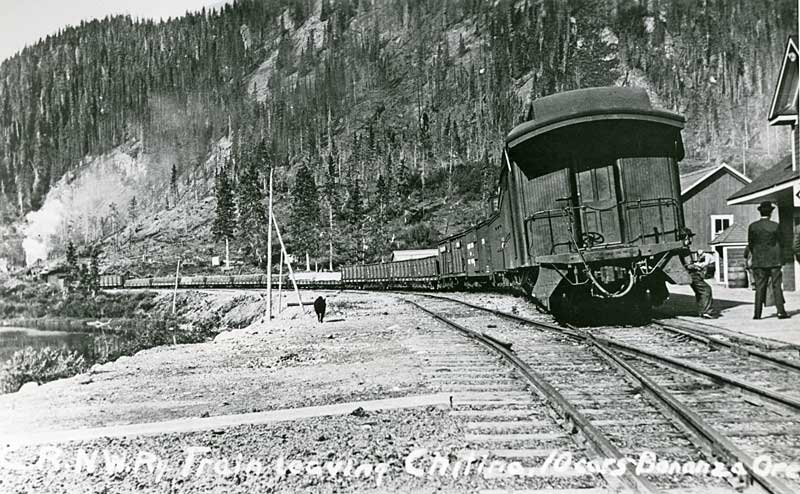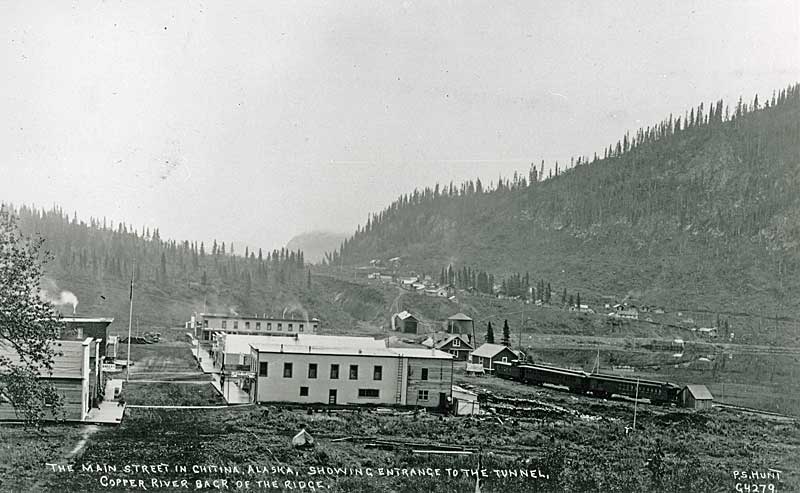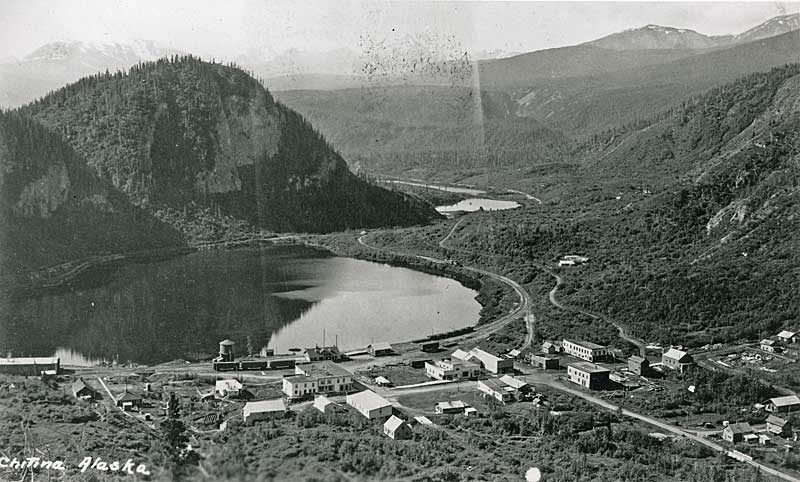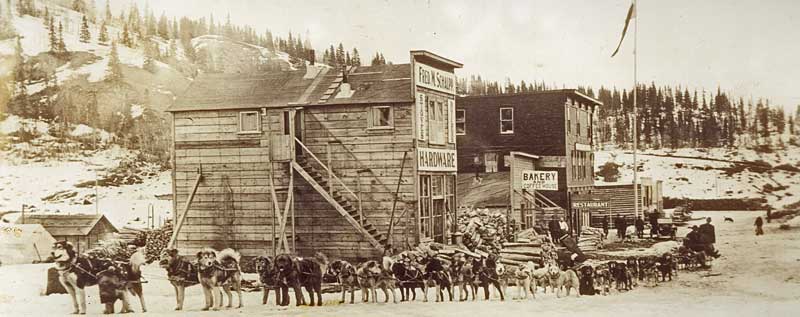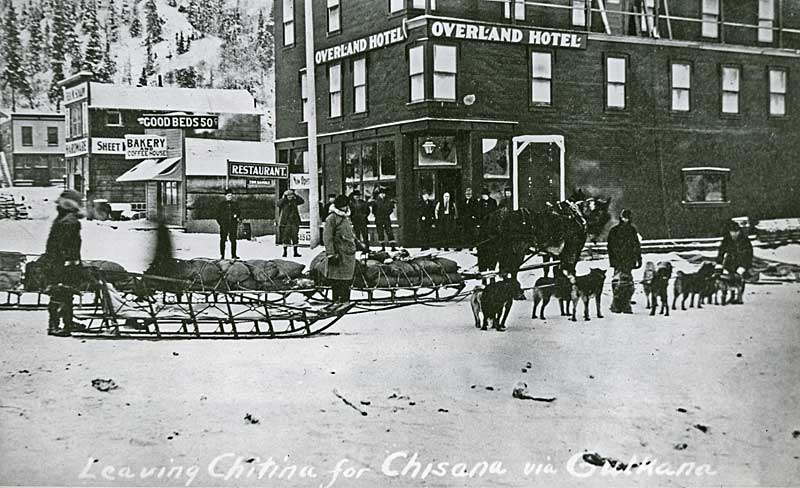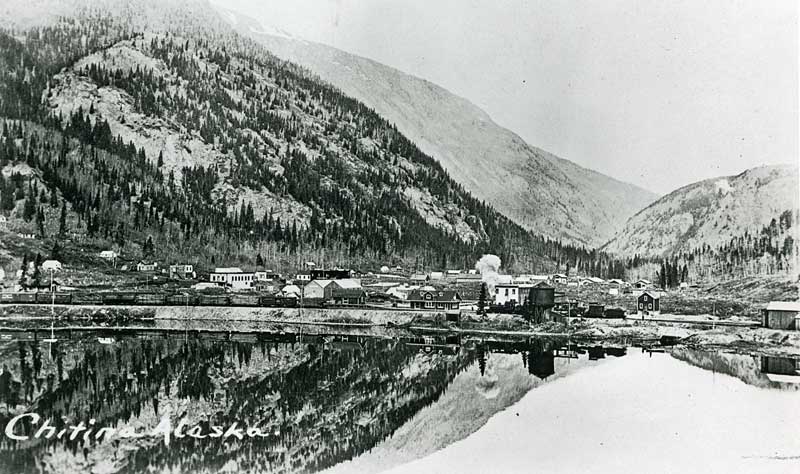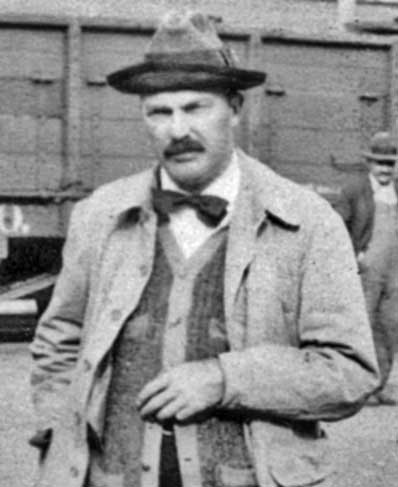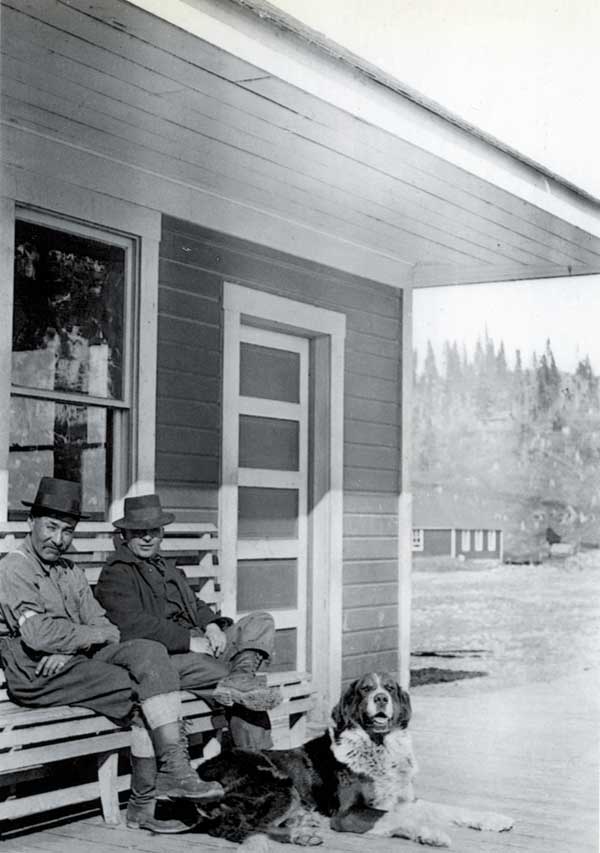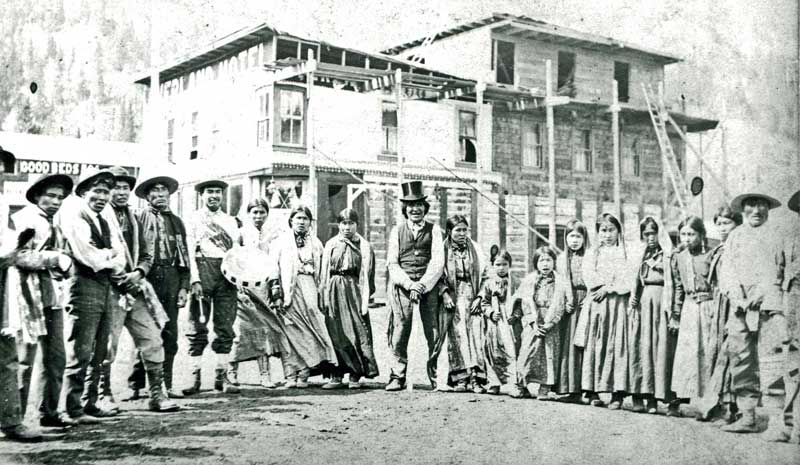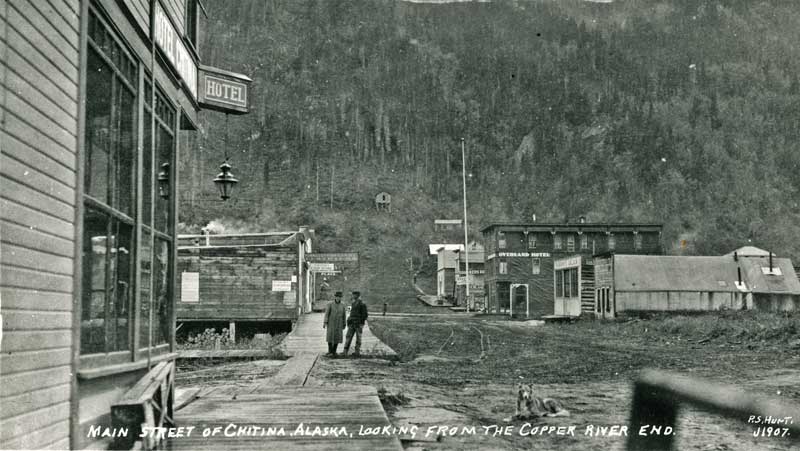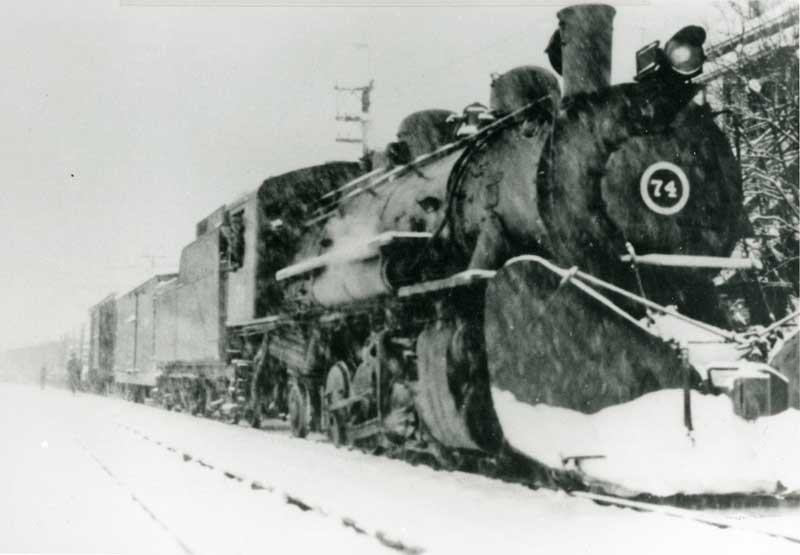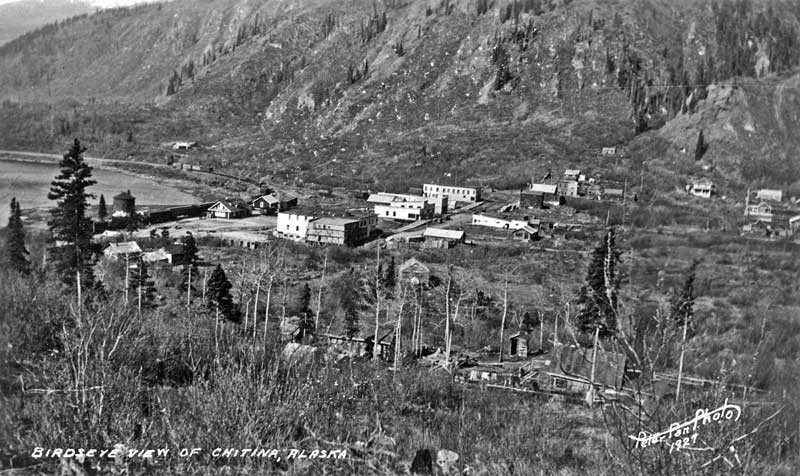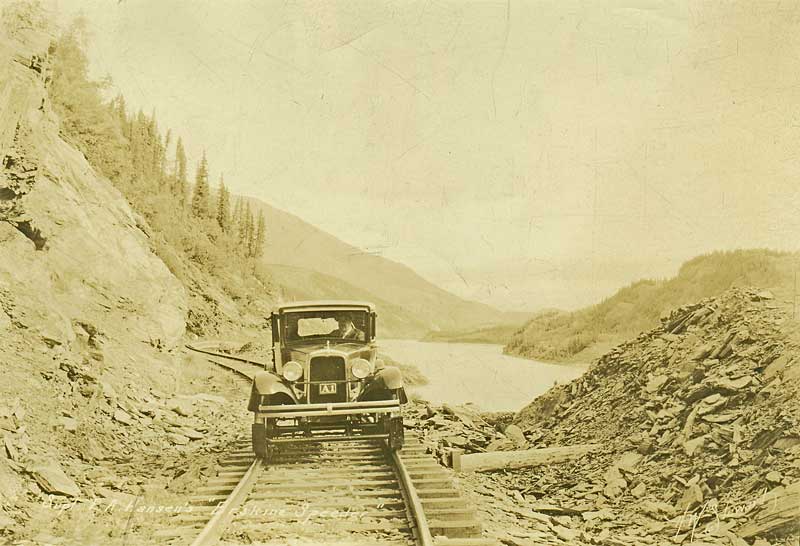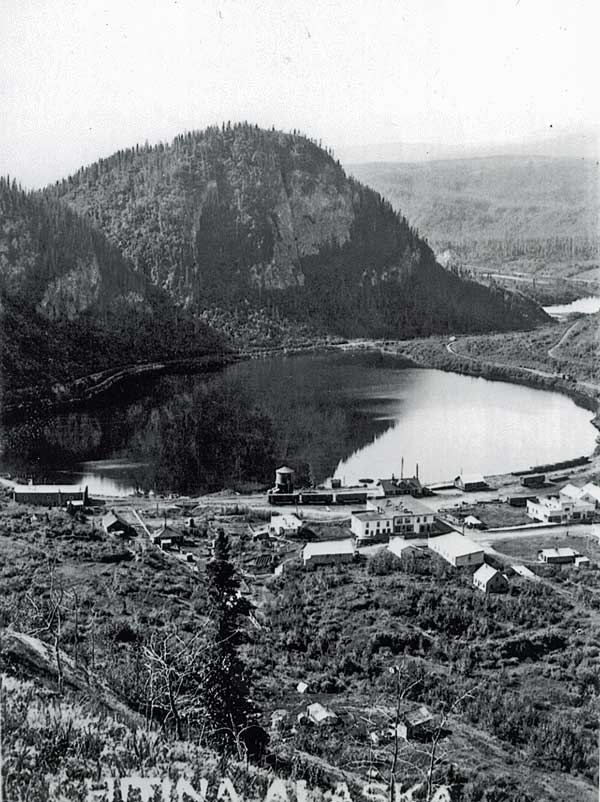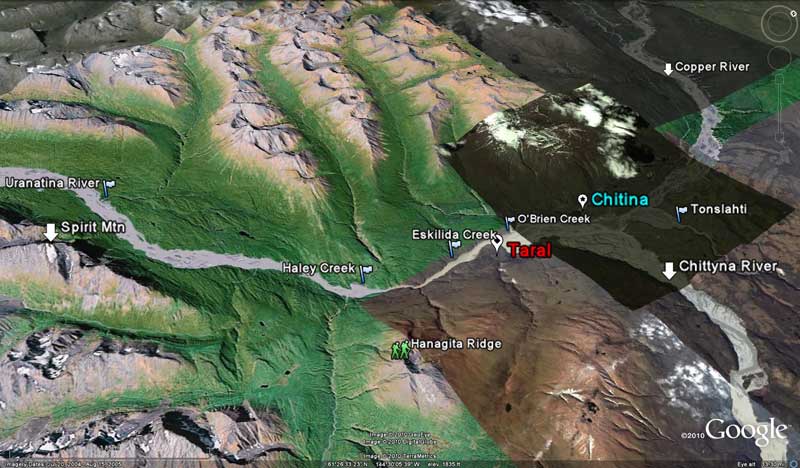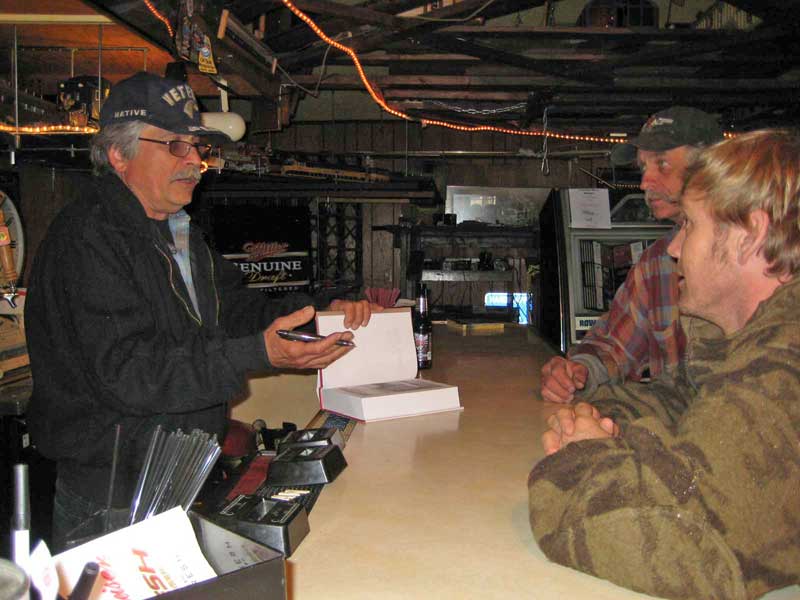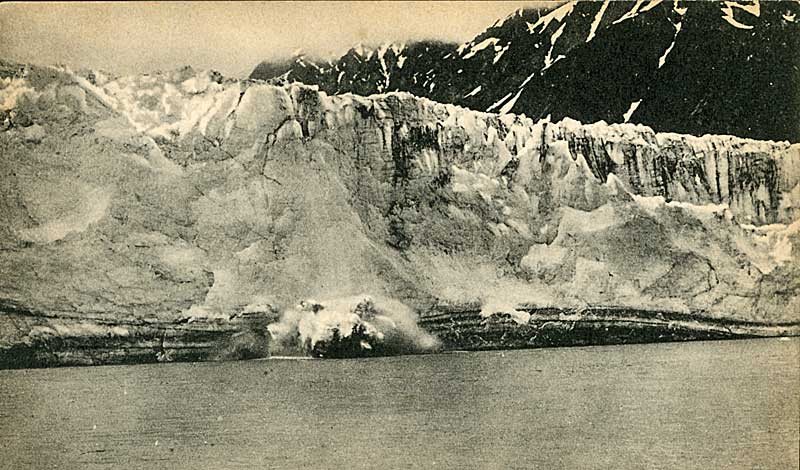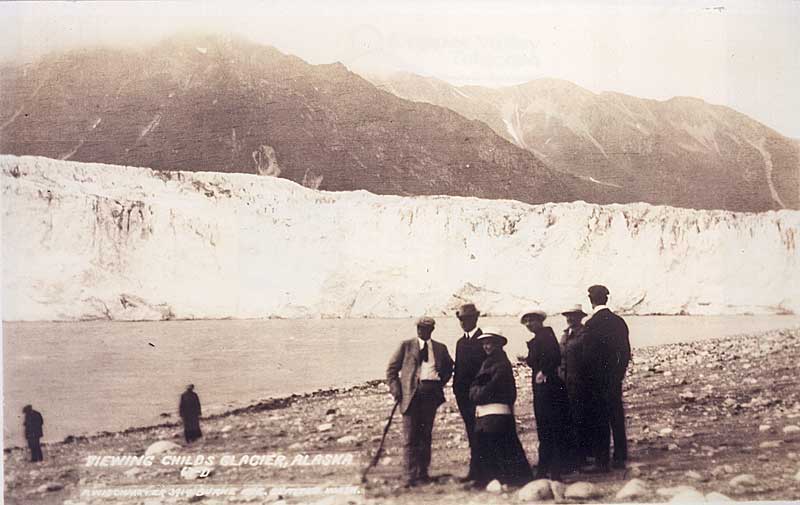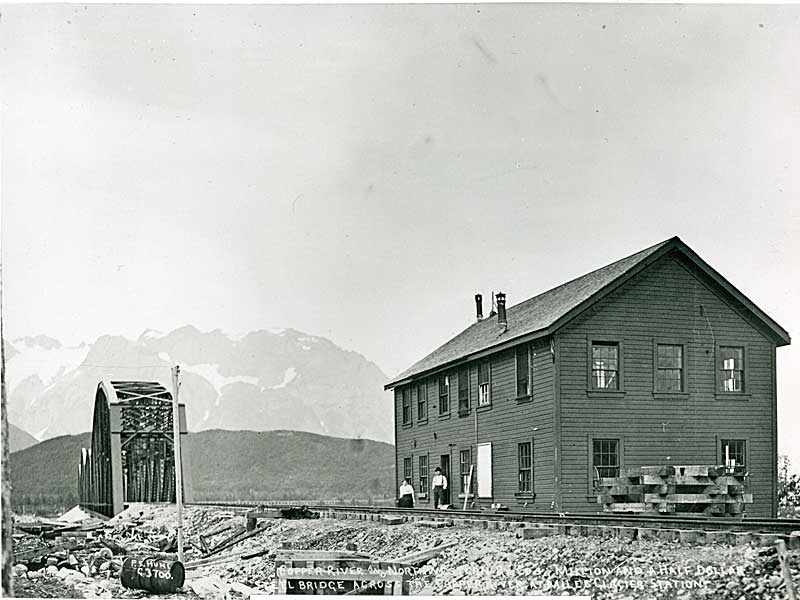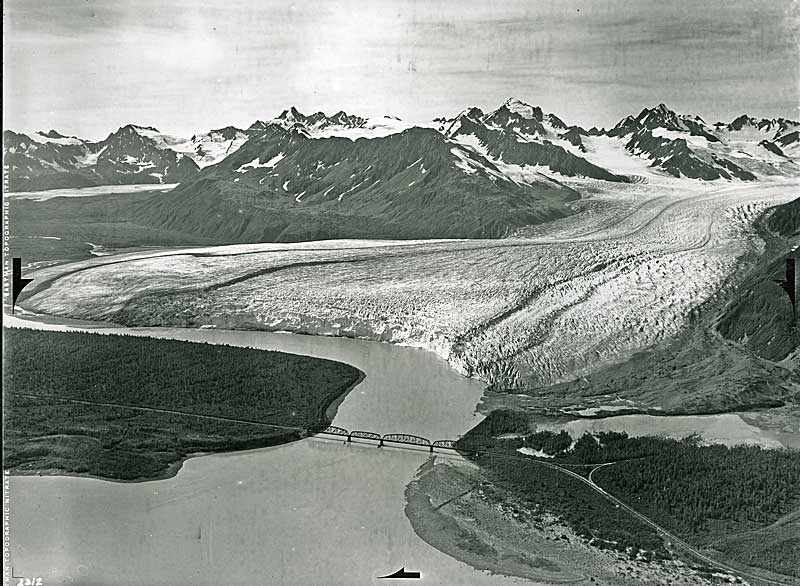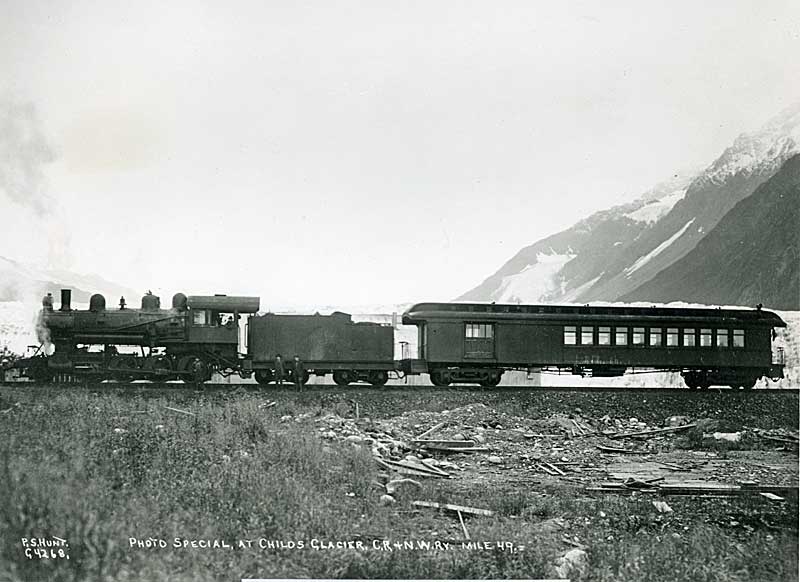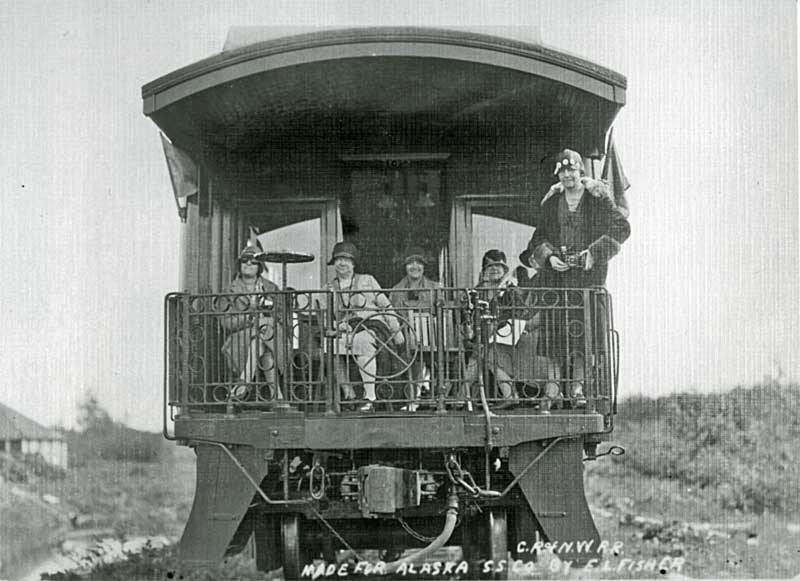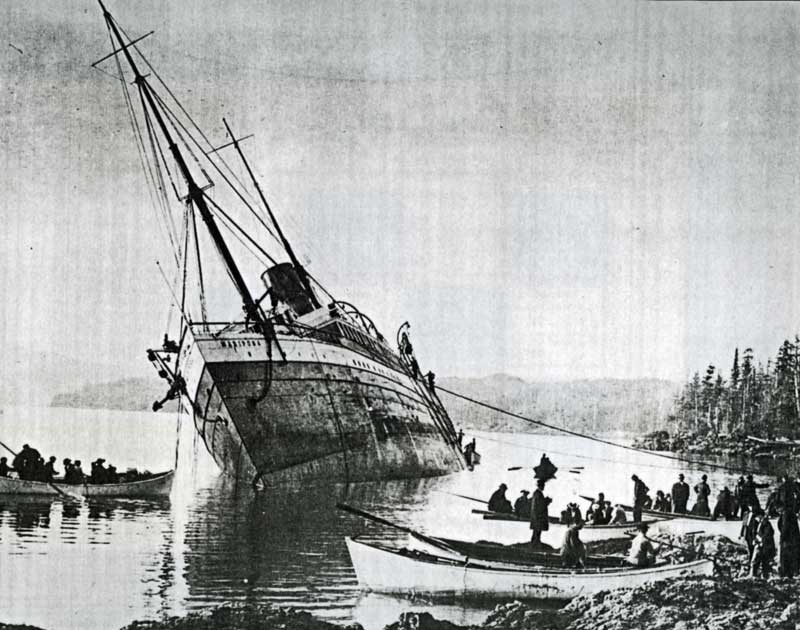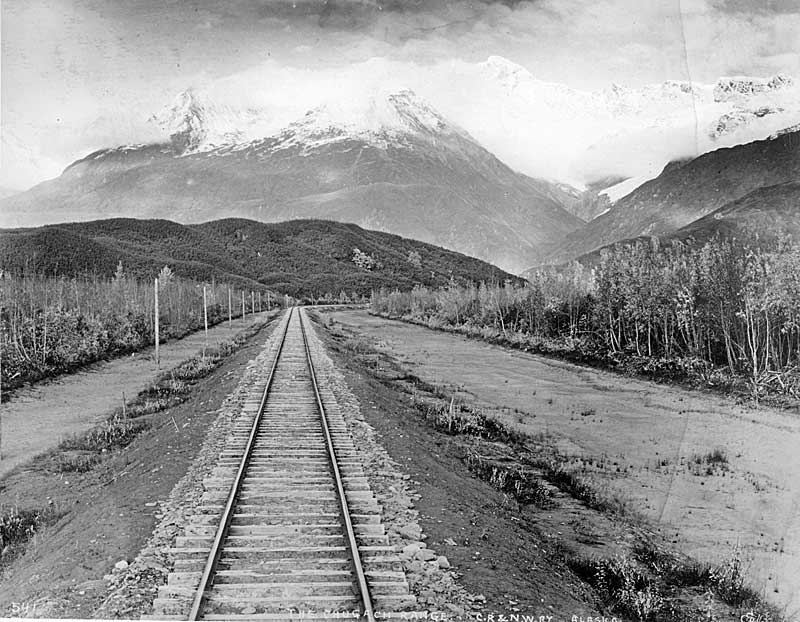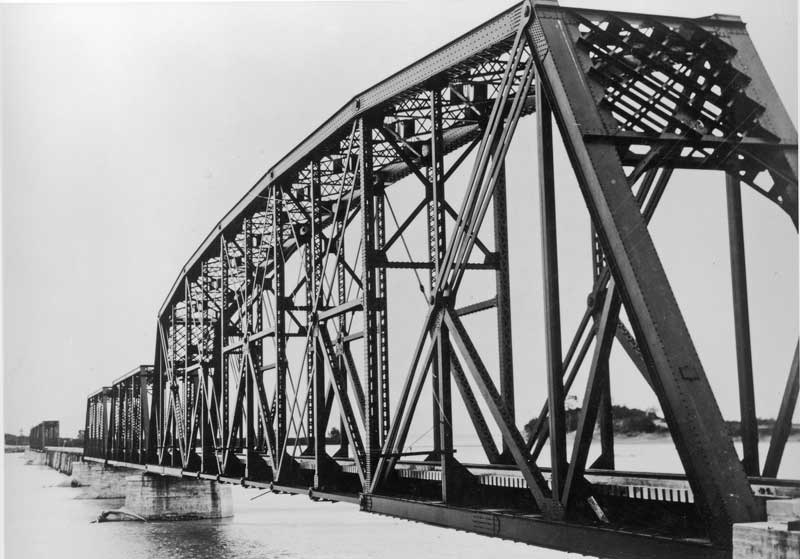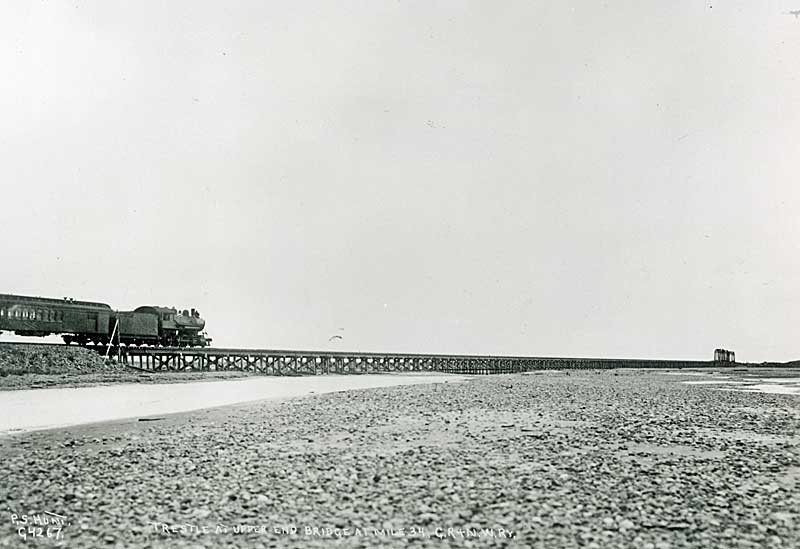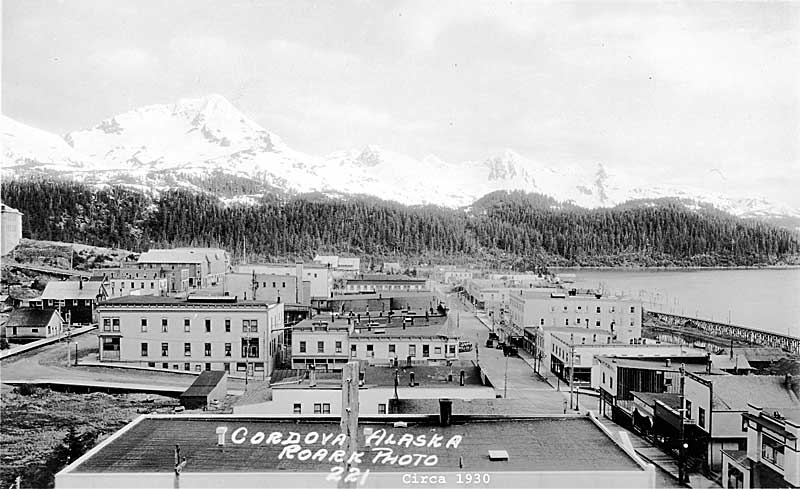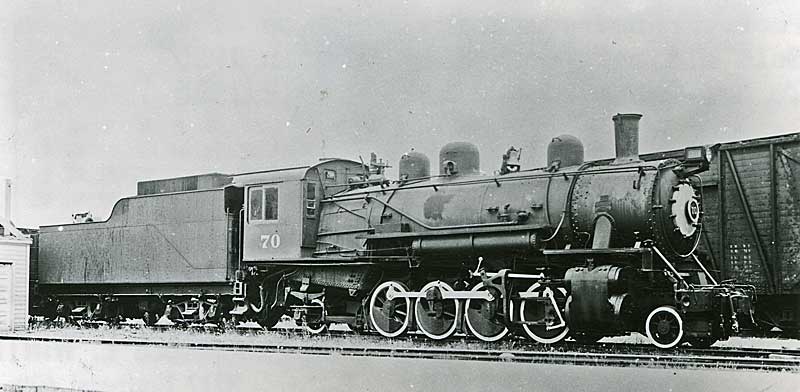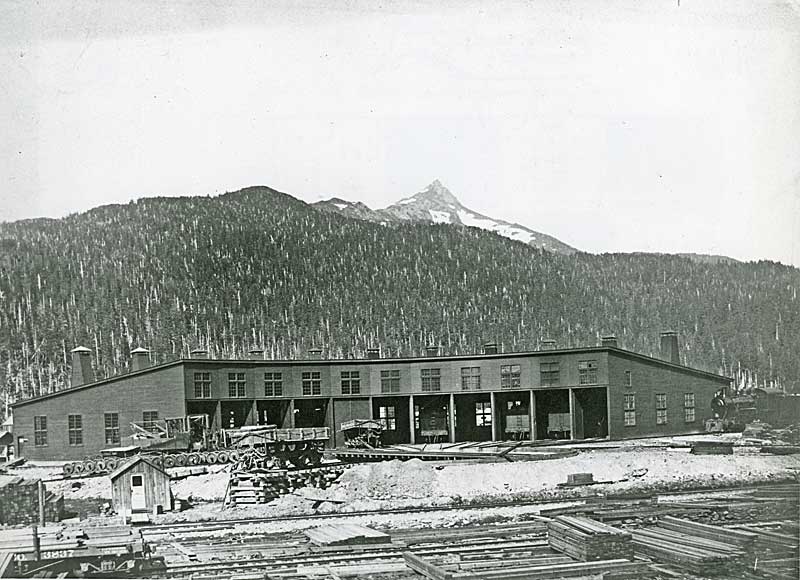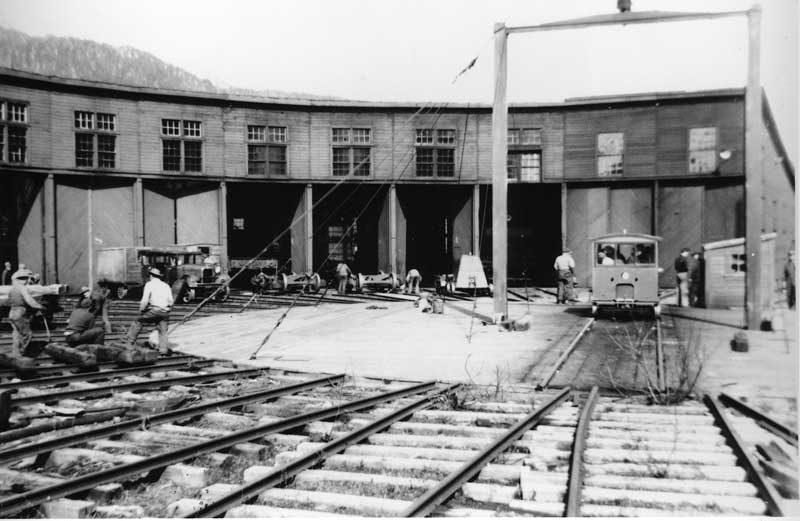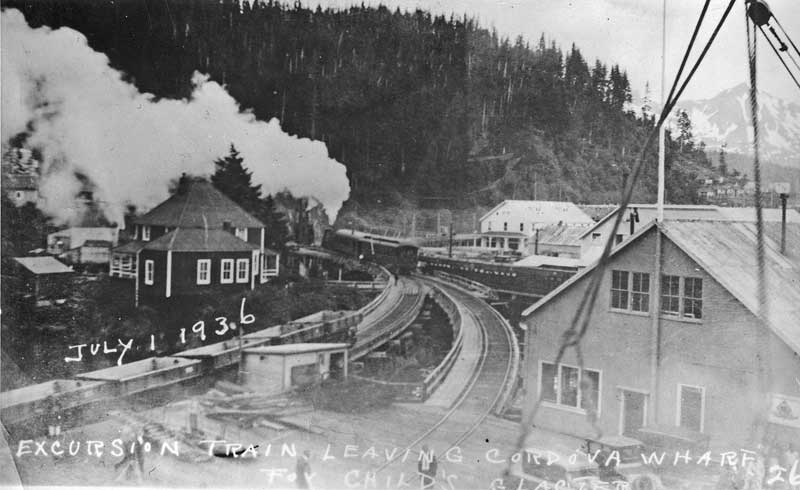Legacy of the Chief, Chapter 14: "Johnny Gakona Signs On" |
Chapters from the historic novel "Legacy of the Chief," by Ronald Simpson, and other items mostly related to the historic background of the Ahtnas in the context of Kennecott Copper & its Copper River & Northwestern Railway.
07 November 2010
Ch 13, Pt 3, "Ketcheeteneh Birch and Johnny Gakona," -- 1916
Chapter 13: "Ketcheeteneh Birch and Johnny Gakona" - 1916, conclusion |
click on picture for larger image: some of these images appear in the book for this chapter. |
“We Indians are special too, Johnny. “What do you mean, Tom?” We of the ‘Atna’ tuu Ts’itu’ are part of the railroad now. Indian crews keep it running and we ride it for free. They have had to accept us.” “Is that a good thing? Sometimes when I listen to Grandfather I wonder.” “Don’t be fooled by Nicolai. He’s the reason it happened. Better us than someone else, Johnny. Besides, so much easier to hunt riding train than on foot. It’s our railroad now.” Tom set down his stick and handed Johnny the dollar. “You’re too good for me. Really good. Have to go Johnny. My wife expects me to be home. They may need me early tomorrow. Have to be ready. Say hello to your mother for me.” Johnny sat down on the bench running along one of the two large windows facing Main Street. Some of the older men entered and filed into the card game in the rear to match their skills against those of Nicolai, who worked the cards with the skill, perhaps even collusion, of Yaabel himself. All the Native elders knew when he was in the card room. Nicolai became a magnet for people who simply wanted to be in his presence. Nicolai excused himself from the card game to resume playing billiards with his grandson Johnny. The two of them were alone in the room when the solitary figure of Stephen Birch walked in. Nicolai was facing away from the door, lining up his shot, when he heard the door open. Without turning around to look, he greeted Stephen Birch. “Hello Mr. Ket-chee-ten-eh . It is good you are here.” It was a nick-name he had given to Mr. Birch long before. Nicolai equated Birch with the railroad, even though Birch neither built nor ran it. Birch was just the deal-maker. Nick-naming others was an Indian form of familiarity. Nicolai turned around to shake the hand of Birch, who already was extending his hand. “I don’t know how you do that, Nick. You couldn’t have seen me coming in.” “Heard your footsteps. Know them well. This is my grandson, Johnny.” “So you are the Great Man, Mr. Stephen Birch. Pleased to meet you.” The man’s eyes softened up slightly. He smiled and shook hands with the young man. “I am indeed Stephen Birch. Don’t know where this Great Man business came from, though. I’m just another arrogant old fool who’s lucky more than he’s not. “I’ve heard of you through your grandfather who speaks very highly of you. Very glad to meet you, young man.” Birch had a stalwart and robust presence fitting his position as head of the corporation which, for all practical purposes, owned or controlled this part of the Territory of Alaska. “Please, continue with your game. Don’t let me get in the way. I’ll challenge the winner. I rarely get to play anymore except when I visit this territory.” The door opened again. It was Birch’s aide. “Sir, if you want, I’ll send over the brandy and cigars now. Will there be anything else?” “Thank you, Dermot, that will be all.” The man nodded politely to the three men and quietly departed. Johnny deliberately missed the next shot, giving the game to his grandfather. Nicolai took the winning shot. “You’re up, Ket-chee-ten-eh.” Birch nodded, then started to pull out a cigar. He looked at the chief. “Care for one? I have more coming,” he said as he extended a cigar toward Nicolai. Nicolai accepted. Both men lit up. The chief was just a few years older than Birch, though considerably smaller in stature. Johnny observed that somehow the two seemed to fit well and comfortably with each other. Nicolai waited for Stephen to break the triangle of balls on the table. “Put up dollar. No shoot for free.” Birch took a coin out of his pocket and tossed it on the table. “You have new woman. Good choice?” “Not if I had to live here, Nicolai. She’s decided she doesn’t like Alaska, no matter what. Not at all. She wants me to cut the trip short. A severe storm in the Gulf of Alaska came out of nowhere just as we were approaching Cordova. It rattled her so badly, I think it ruined her trip. She got horribly sick on board and needed several days to recover in Cordova. Now she just wants to go home.” “Yet you came to Chitina anyway?” “Unfortunately it was I who made the honeymoon plans. I combined this with a business trip. Big mistake. Now we’re committed. We have to go on to Kennecott, even if it’s just for a few days. It may be some time before I can make this up to her.” “Engii. Never let woman set course.” “You live in a much different world, Nick, but I hear that even your own Native women have changed from what they once were.” The chief thought about this for a few moments. Then he made a took a shot and successfully landed his ball. As he walked around the table to follow up, he looked back toward Birch. “Your ways infected our women. They no longer listen to us as they once did. Once I had many women. They obeyed. Your missionaries made chief give all women up except one. She died. Now chief has no women. Maybe just as well.” He aimed and took another shot. It landed. “No mercy for white man today.” He landed the eight-ball. “White man lost.” He nodded and waved Birch back into the game. “Put up your coin. New game. Second chance to beat chief.” The door opened. An oriental waiter from the hotel came in with the brandy flask and glasses plus a box of cigars. Birch looked at Johnny, but the chief gave his grandson a forbidding look. “Grandfather won’t let me drink, but thank you anyway, Mr. Birch.” The Japanese waiter poured brandy into two glasses and departed. “Our women served us like that. No questions. No arguments. Your women no good. You pay for service. Now we pay too. We listen to them complain. They tell us they can get other men. Better men than us. No good attitude anymore. “Maybe you should take her back, this woman of yours. Trade her in. Plenty of women waiting for rich man like you.” Birch contemplated the chief’s words with considerable amusement. “I married late in life . I’m very lucky to have anyone who would put up with me and my arrogant ways, especially someone as gorgeous as Mary. This is my fault. I should have planned a honeymoon in Paris. She’s a sophisticated city girl who doesn’t appreciate places like this. Even now, she’s sulking in our suite in the hotel.” Birch looked up to see his waiter shaking his head. “What is it, Chen?” “Wife Mary is in main lounge of hotel drinking gin, sir.” Birch immediately showed a sign of alarm mixed with pain. “You should go home, Ket-chee-ten-eh. Turn around. Go back to Cordova. Take ship home, if you want to keep her happy. Can always do business later, but you only have one woman. I know. I still miss Udizsyu, who was best woman I had. Better to keep your woman happy than pay later.” Birch considered this, then racked the balls on the table. The chief positioned himself for the opening shot. “Maybe she’ll learn to accept the beauty of this place, but it’s too late now anyway. The men with me are big investors who are here to see Kennecott for themselves. I promised them that. Can’t turn back now, even if I wanted.” “You have set your own fate, but you are right to live by your words. Can we help you here?” the chief offered. “Thank you for being so kind, Nicolai. You have already helped. I wish the hard-nosed men I deal with in New York were as understanding as you. Is there anything I can do for you?” The chief broke the rack of balls and landed one in a pocket. “Just don’t run over any more of our graves. Difficult to rest in peace when bones are scattered like bear-kill.” “You have my word, Nick.” “And one other matter. I asked you before about Johnny.” “You were serious? Then so am I. You have my word on it.” Stephen landed a ball. Then another and another. “I have you on the run now, Nicolai.” “Don’t be so sure, white-eyes.” Birch missed. The chief did not. Then Nicolai ran the table. “It’s time to let your grandson Johnny back in the game, Nick. I need to sit this one out. You blasted me right out of the railroad bed on that run. Give me time to collect myself.” Nicolai, smiled then signaled Johnny to rack the balls. No one else could ever get away with calling him Nick. The Great Man sat back and re-lit his cigar. Both men had each taken a small sip out of their brandy snifters, but that was it. It was just a formality for them. Smitty returned from the card room. “Billum is holding up the game for you. He wants a chance to win his money back. You better come.” “Have to go back to poker game. Ket-chee-ten-eh, join us now or later?” “Maybe later, thank you. I want to test my skills against this young man. Nick, you go ahead without me. He and I have to talk.” Birch gave a sly wink. The chief revealed one of his rare smiles, waved at Birch, then disappeared into the card room followed by old Smitty. Johnny and Birch were alone, except for the Oriental who stayed with the brandy and cigars. “Chen, would tell my wife that I’ll be returning soon?” Chen bowed and left the room. Birch set up the rack and shot. He pocketed one ball and followed with a second shot, which he missed. “Your grandfather is a remarkable man, is he not? He said the same thing about you. He wants you to have more education--much more.” Johnny had been concentrating on game on the table. He mentally lined up a series of shots and proceeded to set himself up. He decided he would not let Birch win. He could not quite run the table, but was able to block a likely shot of his opponent. “You’re a very intelligent young man, but opportunities in Chitina or even Alaska are very limited. We will help you, if you want. I have already given my word to Nicolai. It is only necessary that you work for us first.” Birch took the shot and missed. He found he had been set up. Johnny’s path was now clear to win the game. “I will ask the railroad superintendent to find you a position. He might have one at Cascade station. If that’s true, it’s yours if you want it.” Johnny looked at the man in silence, needing time to digest the unexpected offer which could change his entire life. “Say, you shoot like a real pro, Johnny. I’m impressed. You need a nick-name that fits your style of shooting, something that sounds catchy. Let me think about that. “Your grandfather stuck me with Ket-chee-ten-eh, without asking me, so now I’m going to return the favor. Besides, most all the men who work our railroad have a special nick-name. “Gakona. That’s it! Johnny Gakona. Nice sound, isn’t it?” Johnny smiled. Somehow it seemed to fit. He nodded. “You taking me up on the job-offer, aren’t you, Johnny Gakona?” “Mr. Birch, you have your Indian.” “Interesting choice of words, Johnny Gakona.” Passing time at the Chitina Depot --Candy Waugaman collection Continue with Chapter 14, "Johnny Gakona Signs On" |
Ch 13, Pt 2, "Ketcheeteneh Birch and Johnny Gakona," -- 1916
Chapter 13, Pt 2: "Ketcheeteneh Birch and Johnny Gakona" - 1916 |
click on picture for larger image: some of these images appear in the book for this chapter. |
The young man watched the elite party walk from the depot platform, completely enthralled by the odd scene of so many well-dressed people on the dusty streets of Chitina. He already knew that the Stephen Birch was expected, but Johnny had never laid eyes on him. Something about the sense of power which surrounded the Great Man fascinated him.The older Indian looked upon the spectacle while revealing nothing in his expressionless face. When they were both satisfied that they had seen enough, they nodded at each other and stepped back inside the billiards hall. The no-name billiards hall was a common meeting ground used mainly by the local Indians. Many other places in Chitina remained off-limits to Indians and half-breeds. For this reason alone the older Indian seldom entered town. He chose not to be a part of a system he considered unjust and highly offensive. But the no-name billiards hall had an unusually strong appeal because of its function as a familiar gathering place for all the Indians, attracting the elders, such as Nicolai, Eskilida and Doc Billum, who would spend many hours gambling small sums in the card room in the rear of the building. The billiards hall in front primarily served as a meeting-place for the younger Natives. Smitty was a very accommodating proprietor. A considerable amount of trade occurred at his place of business, providing the old man and his much-younger wife Rita a comfortable living for many years. “It is Birch himself, Tsuuye He has brought his new bride to visit his copper mines near our sheep-hunting country.” The older man held a grudging admiration for Stephen Birch. He had met Birch in the early days when the Great Man had just acquired the Bonanza claims, and was in the process of attempting to prove the value of the prospect as a lode mine worthy of the serious investment of a railroad from Valdez to Bonanza. Only later was the port location changed to Katalla and then, finally, Cordova. Birch homesteaded the Chitina town site long before the railroad arrived because he recognized its value as a key transshipment point. He made a point of visiting the chief at Taral, just as Lt. Henry Allen had done years before because he knew that no real peace was possible without the assenting nod of the chief. Birch took great care to show respect for the Nicolai. Whatever might have been the ultimate motivations of Birch, he understood the extreme importance of granting the chief proper recognition of his status. Nicolai looked upon the railroad in the same way he viewed Birch. Birch could be either a friendly or an evil power. His supremacy over the area was subtle, but his far-reaching power was of a magnitude which could easily threaten what remained of the way of life of Nicolai’s people. The railroad was the most prominent symbol of the Great Man’s power. The changes caused by the enormously rich copper mine and its railroad forced the chief to re-examine the core of his traditional spiritual beliefs. He could no longer look at his Creator in the same comfortable way, for the chief’s very basic assumptions had been severely challenged by these changes brought on by Birch and his railroad. Nicolai was forced to seek answers deep within himself. Before the coming of the white man, the elders had a traditional approach to every situation. Hotel Chitina, 1910-1920 version --Lisa Yoshimoto Hotel Chitina , 1920-1940 version after additions --Candy Waugaman Those days were over. No one was prepared to deal with the world of the white man. The tyone found himself standing almost alone in trying to find a way to fit his people into the new world which had arrived with the alarming speed of less than two decades. Some had adapted well to the change. Men like Tom Bell or Doc Billum had learned to prosper with the new opportunities while maintaining their Native ways. Regrettably, most the others failed to adjust. These were the greatest victims of the scourge of alcoholism, the disease which came from despair and a sense of unworthiness. It was typical of Nicolai to continually look for opportunities in the midst of change. When the right moment came, he had two conditions ready for Birch when the Great Man finally came to him for help to bring to an end a potentially disastrous situation for the railroad in its relations with the Indians. The first was that all the Indians living along the railway should be able to ride the train within their traditional hunting and fishing grounds without charge. The rails paralleled two traditional routes which had once taken days to traverse. With the use of the train, any of those same places could be reached in hours at most. More important, Nicolai wanted the railroad to hire his people for the seasonal maintenance work near Chitina. The railroad brought with it a cash economy. Railroad employment allowed the Indian men to work for cash for a few months every year. The arrangement worked out well for both parties. Few Native men were inclined to work year-around, but many desired seasonal employment as long as it did not interfere with their hunting, trapping, fishing and other traditional activities. The spring maintenance and rebuilding schedule required considerable manpower which could readily be found within the ranks of the Native population. The Native men of Chitina were hard-working and reliable, if only for those few months of the year. That was all which was required.
Nicolai laid the matter very plainly and forcefully before the Great Man. If he wanted to be assured the continued ability to operate in peace in the Copper and Chitina River valleys, especially in light of the clumsy manner in which the railroad had handled Indian relations by allowing the desecration of the grave sites at Eskilida camp, he had better concede to Nicolai’s requests. Birch weighed the alternatives and quietly acceded to the demands. The chief got his way. The CRNW and the Indians had become life-long partners. Only a very few were aware that these things were made possible because Nicolai and Birch worked together on the arrangements. The traditional chief, much like Birch, preferred to remain in the background rather than allow people to comprehend the true power which the chief silently and expertly commanded. Nicolai had long given up his role as formal leader of our people. Never again would another Ahtna tyone emerge. Chief Goodlataw took over the duties of Nicolai at Chittyna so effortlessly that Nicolai felt it was safe for him to quietly vanish into the background. Yet Stephen Birch found that only Nicolai had the power to help him when those early problems between the railroad company and the Natives surfaced. Doc Billum took the role of chief at Tonsina. Billum was an Indian capitalist of the first magnitude who made a small fortune due to his Copper River ferrying service and his ability to trade goods and services the white man wanted in return for anything from cash to whiskey to favors. Like Nicolai, Doc Billum realized very early that with the coming of the white man, new opportunities abounded for the clever Native bargainer. It was the rare man, Native or white, who was able to gain the upper hand on Doc Billum, who soon became the most practiced of any Indian in the art of trade. Billum’s most notorious deal became known as the Billum lode fiasco. He sold rights he never had to a prospect that amounted to nothing--much like the Nicolai Prospect--for a sizable amount of tobacco, rifles, whiskey and cash. Recognizing the lure of old Indian legends made up mainly by white men, Billum created his own version of the more famous Nicolai Prospect, by inventing another “old Indian legend” about an exposed copper vein which was said to be “richer than the Nicolai lode,” and which could be found well up the Kotsina River in a place known only to Doc Billum. He sold the entire bill of goods to a group of prospectors who thought they were tricking Billum into giving away a fortune in copper mining claims. A copper showing did indeed exist, but it was nothing more than copper stain on the rocks, typical of many of the outcroppings in the area. Billum had no true claim to that worthless piece of ground at all. He had trapped the area in his youth when he stumbled upon it. Doc’s knowledge paid off. The greedy prospectors were too embarrassed to admit that they had been fooled by a “siwash” Indian whom they thought they themselves had swindled. They never admitted that the claim was worthless and never demanded their money and goods back from Doc Billum. Johnny took a shot on the billiards table. “Will I be able to meet him?” “He will be here. Be patient. He will come alone.” The younger man beat his grandfather handily at the game. Nicolai decided it was time to return to the card game in the back room where he almost always won. About that time Tom Bell entered. He was finally off for the day now that the train arrived which included the diner car where Tom worked. Tonight he would be home, for his wife lived in Chittyna village. Tom was ready. The billiards game was on. “Ready to shoot a good player, Johnny?” “Ready to lose, Tom? One dollar and you’re on.” Tom threw a silver coin on the table. “You’re on, foolish one.” “We’ll see who’s the fool. How was Cordova, Tom?” “Miserable, as usual. Too misty and cool even in the best Cordova weather.” Tom took a shot to break the rack of balls. None fell into the pockets. “It’s open, Johnny.” “So I see, Tom. What’s it like, serving those elite big-whigs?” Johnny looked over the table of scattered balls carefully until he determined a path of attack. He began placing a series of shots until he missed on the fifth ball. He had been careful to leave Tom no openings. “Good run, Johnny. The elites? They’re just like anyone else, except they have more money and think they own the world. Birch even gave a toast to his success in conquering this land. What nonsense. He has a tough lesson coming. “But that’s white man’s foolishness. I just give them what they ask, stay out of their way, and say nothing. Even played cards with Mrs. Birch. She’s good at poker, but she’s mean and underhanded. It shows in her card-playing. I beat her anyway.” Tom realized that Johnny had blocked his path at all points. He tried a desperate maneuver on the table, but missed, failing to drop even one ball. In the process, he gave Johnny the opening the young man had counted on. “So that was her with the Great Man?” ` “Mr. Birch you mean? That’s his wedding party out there. Did you see the big new train? Special for him. Special car, new engine.” “I heard the different whistle and saw it pull in. Quite a sight. Impressive.” Johnny took one shot and then another. He began to clean the balls off the table. Tom could see he was going to lose his dollar. This kid was an expert at his chosen game. That was clear. Chitina Depot -- F.C. Mears, 84-80-54N, UAF AK & Polar Regions Depot
|
Ch 13, Pt 1, "Ketcheeteneh Birch and Johnny Gakona," -- 1916
Chapter 13, Pt 1: "Ketcheeteneh Birch and Johnny Gakona" - 1916 |
click on picture for larger image: some of these images appear in the book for this chapter. |
06 November 2010
Intermission, Pt 2
At one time all of these chapters were available on line, although you had to pay to see them. I ended that about two years ago due to lack of interest. I never was a good self-marketer ! I have no idea how many hours I spent setting each of those sixty-one separate segments up and then selecting and scanning the individual photos and maps. That was THEN.
Now I am editing those same original chapters. Each time I go back I find more that has to be redone. The version I have is NOT the final version. That is held by Publications-Consultants, who did not provide me with that copy (I would have to purchase my OWN work from them !). Because this is not the final edited copy there are plenty of grammatical errors, including problems with sentence structure, repeats of words and just plain bad writing. As I catch these, I correct them. That means that this version will be different from the one that appears in book form--it should be BETTER ! My apologies that some of what you read might be a little rough. I am getting to it as I can, but it will all take some time. Meanwhile I am simply posting what I have and hoping I don't need to make too many corrections !
Then there is the photograph editing. First I have to select which photos to use. I consult the novel to see what I use there. In most cases I use those images and select others as well that fit in but did not appear in the original two editions. I locate these images on my library and then scan them if they are from the old photo collection, or recopy them if they are from the more recent electronic files I maintain. I have hundreds upon hundreds of these images, so I have considerable work simply in locating the image files I intend to use.
EVERY single photo has to be re-scanned (or recopied if on electronic file), and often photo-edited for clarity (adjustment of contrast and sharpness and sometimes the use of the Gaussian-blur function). Then each new file is presented in a larger format than I made available before. The old ones were no more than 1200 pixels wide and sometimes those photos were only 800 pixels wide or less in their largest form. By contrast, these newly scanned images are typically 2250 pixels across. Some are 3000 pixels-wide or more, if the photo warrants it due to the detail that may be present in some of them. Then I cut a smaller version, usually 800 pixels wide. This is the one you first see on the post. I then take that image and reduce it further, usually to 640 pixels wide, in order to meet the limitations of this blog set-up.
I like the 800 pixel width because it offers better clarity. This is the preferred size I will use elsewhere. And these, in turn, will link directly to the larger images which range from 1600 to 3000 pixels wide, depending on the nature and origin of the photo. I store these images on line in one of two sites I maintain. I store most of my newer scans on my personal website, http://copperraildepot.com. The rest are located in my Photobucket account. This means that after scanning each image, I must upload the two sizes (and sometimes a third thumbnail size) to one of the two websites before I link the images to the relevant individual posts in this blog.
I like the 800 pixel width because it offers better clarity. This is the preferred size I will use elsewhere. And these, in turn, will link directly to the larger images which range from 1600 to 3000 pixels wide, depending on the nature and origin of the photo. I store these images on line in one of two sites I maintain. I store most of my newer scans on my personal website, http://copperraildepot.com. The rest are located in my Photobucket account. This means that after scanning each image, I must upload the two sizes (and sometimes a third thumbnail size) to one of the two websites before I link the images to the relevant individual posts in this blog.
The original hard copy photos then have to be refiled in their respective albums, of which I have many. The typical photo is an 8 X 10. I acquired those when they were far more affordable back in the early 1990s. I also obtained a set of smaller ones, mostly 4 X 6s, from the Cordova Museum back in 2004. These are still large enough to enable me to obtain good electronic copies. On this blog you will not be able to tell the difference.
These are exceptional quality photos, not just in their technical detail, but in their unique perspective. You will not find anything else like this on the topic of Kennecott, its CRNW Railway and the Native people of the time anywhere else.
Thus, each chapter I present represents a considerable amount of new work before you see it. Often I will spend all day on just one chapter, although I have done two chapters in one day before, but that is very time-consuming. Then I go back and link them together, chapter to chapter. And, finally, I create a master list which I present on this blog from time to time, moving it up to the top as I add chapters. The latest version also includes a thumbnail photo for each chapter that is also directly linked to the specific chapter represented by the photo.
Thank you for becoming a part of my historic project by reading this blog.
My regards,
Ron
Below: The author signing his historic novel and presenting it to Rick Schroeder in 2007:
Thank you for becoming a part of my historic project by reading this blog.
My regards,
Ron
Go to: chapter listing
Below: The author signing his historic novel and presenting it to Rick Schroeder in 2007:
Intermission
Hello, readers, whoever you are.
So far I have presented the Preface, plus a dozen chapters, out of the 60 from the full historic novel. How has it been for you so far ? How are those historic maps, drawings and photos treating you ? My guess is that you have never seen almost any of it. I spent many years and countless hours accumulating this material. It is part of a huge personal project. Some of this has never been seen by the public since the days when old Kennecott operated. It is being released here for the first time.
How about the story line ? I have done my best to bring you the people as they really were. These were hardly perfect people, but they are very REAL, don't you think ? Remember, all of this took place a hundred years ago in a VERY different society than exists today.
These first twelve chapters were just the lead-in for the real story that begins in the next chapter. Hope you enjoyed this presentation.
My regards,
05 November 2010
Ch 12, Pt 3: "Mary & Stephen Birch Arrive at Childs Glacier
Chapter 12, Pt 3, conclusion: "Mary and Stephen Birch Arrive at Childs Glacier" | |||||||||||||||||||||||
click on picture for larger image: these pictures are the one which appear in the book for this chapter. | |||||||||||||||||||||||
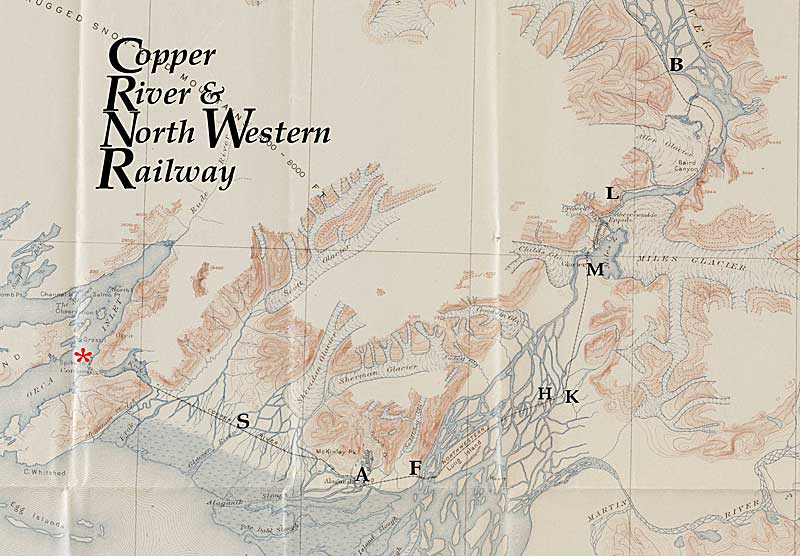 | |||||||||||||||||||||||
1914 Map showing the segment from Cordova (red asterisk) to Bremner (B). Other whistle stops: S = Sheridan, A= Alaganik, F= Flag Point, H= Hot Cake channel bridge, K = Katalla Junction, M= Million Dollar Bridge/ Miles & Childs Glacier, L = Abercrombie Landing. Click map for larger version. --Simpson Files | |||||||||||||||||||||||
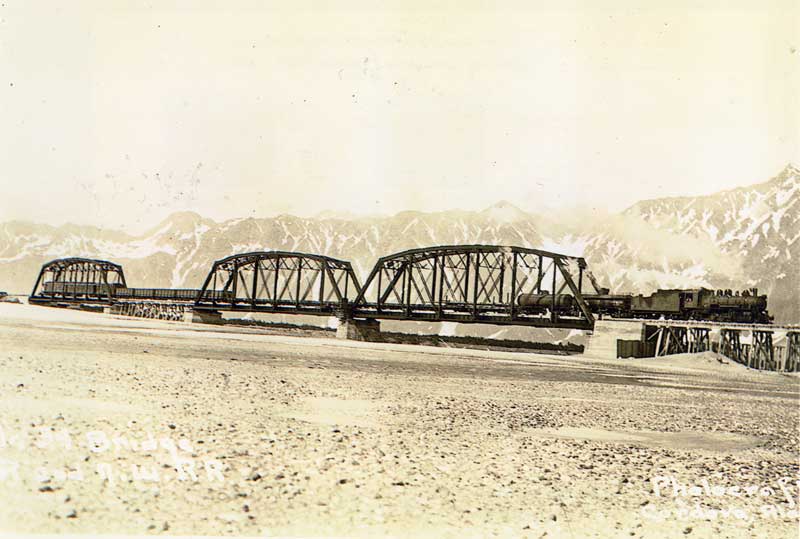 | |||||||||||||||||||||||
Hot Cake Channel bridge, with an unloaded ore train headed east toward Kennecott --Candy Waugan collection | |||||||||||||||||||||||
Below: Consist #70 returns to Cordova --Cordova Museum | |||||||||||||||||||||||
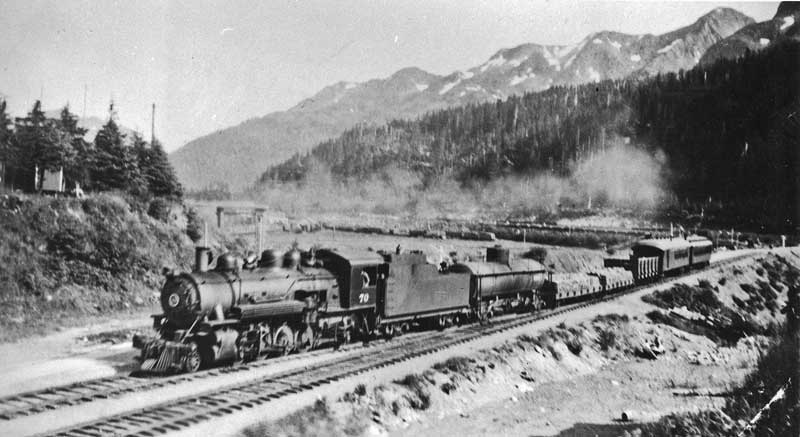 | |||||||||||||||||||||||
The 1,500-foot bridge contained four spans and headed in a northerly direction, cutting a path between the nearby Childs Glacier to the west and the more distant Miles Glacier beyond iceberg-filled Miles Lake to the east. Miles Lake discharged a constant barrage of these icebergs which calved off the distant glacier. These floated toward the bridge, some of them sticking out of the water as much as twenty feet and often striking the concrete icebreakers just upstream from the bridge. Other pieces hit the bridge piers directly at up to twelve miles per hour before entering the main channel under the 450-foot third span of the bridge. Everything then flowed toward the 300-foot tall ice wall that was Childs Glacier. Because of its relatively close distance to the bridge, Childs Glacier appeared to be the larger of the two. It was barely more than a bridge-length away from the bridge itself. In reality, Miles was about twice the size of Childs. The Copper River entered the ice-choked lake from the north at a point about midway between the two glaciers. The river undercut both glacier toes, causing glacial calving which was spectacular to behold. The ice blocks which fell off weighed as much as ten tons and caused tremendous waves. This is most noticeable at the nearby Childs Glacier, where the falling ice sent huge waves of water across the river in the direction of the river bank below the bridge. It frequently beached the migrating salmon, attracting bears which had found the glacial calving to result in a ready source of easy meals. Those waves also threw up tons of sand, gravel and boulders. It was not prudent to stand too close to the east bank of the river opposite the face of Childs Glacier.
Special No. 74 pulled short of the Million Dollar Bridge, stopping on the south end, enabling the passengers to leave the train for a close-up view of the glaciers. Mary chose to stay in the private club car. She, like the others, was amazed at the beauty and massiveness of the 300 foot tall Childs Glacier with its thousands of feet of wall face, but had no desire to step out into the wilderness which lay just beyond the tracks. Even so, wild Alaska has its own way of taming even the most jaded of its visitors. Mary could only gaze on at this spectacle in a state of stunned disbelief and awe. At last she was beginning to understand the attraction which this wild territory held for the great men of action such as her husband.
The car rocked as a gust coming down the canyon caught the car directly on its long side. It was followed by an even larger gust that came blasting through the area. The warmth of the car shielded Mary from the iciness of the wind gusts.
A Native man, who was dressed in a heavily starched white uniform, offered her some freshly brewed tea. She graciously accepted. Mary was beginning to feel ashamed for the way she had treated the help on this trip. “My name is Mary Birch.” “Yes ma’am, I know. I am the cook and sometimes also the waiter. My young helper is out there with the guests in case any of ladies need assistance stepping around the large rocks.” “Are you an Eskimo?” “No, madam. My people are Ahtna Indians. I’m from the Copper River. We’re all Indians around here. No Eskimos except maybe near Cordova.” “Oh. I’m sorry. I didn’t know. What is your name?” “Tom Bell, madam.” “Tom, it is good to meet you. You have a fine, pleasing smile and I like your courteous service. Have you worked here long?” “Almost from the beginning. I like the railroad, ma’am.” Well, it’s been pleasant chatting with you, Tom. Could you find me some playing cards?” “Yes, ma’am.” He skillfully poured the tea and then quietly departed. She turned in the other direction toward the east. She was completely alone in the car now. It was quite a distance across the ice-filled lake to the glacier. It appeared to be nothing but bright white in that direction as far as her eyes could see.
She quietly chuckled to herself at this piece of divinely tasteless bad humor. She was beginning to feel better after several days of illness.
The party had enough of the bone-chilling gusts. The cold wind was causing some of the men and women to develop ear-aches. They began re-boarding the train very quickly after that second large gust almost tore the tied-down large-brimmed hats off of some of the women. The men were able to retrieve theirs. It looked pleasant out there from the warmth of the luxury coach, but the winds were most definitely building up. Stephen found Mary happily playing poker against Tom Bell while sipping on some tea. She was even humming to herself. As soon as Stephen entered the room, Tom stood up and left. Birch directed the train to move to the wye-siding on the north end of the bridge, away from the open area over the center of the bridge which was in the direct path of the wind. The party would enjoy a gourmet lunch prepared by Tom Bell before proceeding on to Chitina. Mary looked up at Stephen from her table and smiled for the first time since they had left Juneau. “Would you and the guests care for a cup of tea before lunch, dear? The tea is very hot after those cold winds you must have found out there. In here it’s simply delightful amid all this spectacular glacial scenery.” Stephen was taken aback. Maybe this trip could be salvaged after all, for Mary was finally adjusting. Stephen and his male guests lit cigars and enjoyed the tea while the cold gusts pounded at the large plate-glass windows, rocking the coach ever so gently. The guests relaxed to a full view of a wild Alaskan panorama which would never again be duplicated once the Copper River and Northwestern Railway ended its relatively brief life. But that was still twenty-two glorious years away. The greatest days of the railroad and the mines which it served lay just ahead. Stephen was optimistic The reports he received from Stannard showed that this had been the best year of copper production ever. His copper mines had no end in sight.
“Gentlemen, a toast. We have carved a copper empire out of this wilderness. The treasures of Alaska are ours for the taking. Everything is paid for, including the steamship line, the railroad, the mines and mill. It’s all profit now. What a glorious future lies ahead for Kennecott!” F.A. Hansen and the other men stood up in response. Hansen responded. “May this, the honeymoon trip of Stephen and Mary be a most memorable occasion worthy of the great man who has made all of this possible.” In those early days when everything on the railroad and in the mines was new and worked well, the general feeling was that Stephen Birch had indeed created an Alaskan copper empire miracle which would go on forever. Over a million dollars worth of copper was crossing the docks at Cordova every month with no end in sight, but the edges of Stephen’s far-flung empire, built on an old notion which mirrored the general western attitude which so unthinkingly supported the outdated concept of American Manifest Destiny, would soon begin to fray, unravel, and finally crumble. In the headiness of the moment, every one of the elite members on board the Kennecott conveniently forgot that the route of the CRNW Railway had already been rejected as the official railroad to Fairbanks in favor of a much more antiquated system out of Seward known as the Alaska Central Railroad. The easy access to the Alaska Syndicate’s Bering River coal fields, which would have guanateed the relatively inexpensive operation of the railroad, had similarly been denied. Most significant of all, the Kennecott engineers were not nearly as optimistic about the longevity of the mines as were the board of directors.
What looked like a multi-purpose railroad made up of both passengers and freight with a guaranteed bright future was only an elaborate mining railroad which dead-ended at the head of what was effectively an enormous box canyon lined with ice. The railroad ended in the middle of nowhere along the side of a dying glacier. That’s the way it would remain, for that was the ultimate fate of the Copper River and Northwestern Railway that it would never go far beyond the shadow of Uk’eledi. | |||||||||||||||||||||||
Mariposa on the rocks: Perhaps the most fitting symbol of Mary Birch's disastrous trip to Alaska was the wreck of the S.S. Mariposa--their cruise ship to Alaska-- only a few months after the ill-fated honey moon trip. . |
Ch 12, Pt 2: "Mary & Stephen Birch Arrive at Childs Glacier
Chapter 12: Mary and Stephen Birch Arrive at Childs Glacier | ||||||||
click on picture for larger image: these pictures are the one which appear in the book for this chapter. | ||||||||
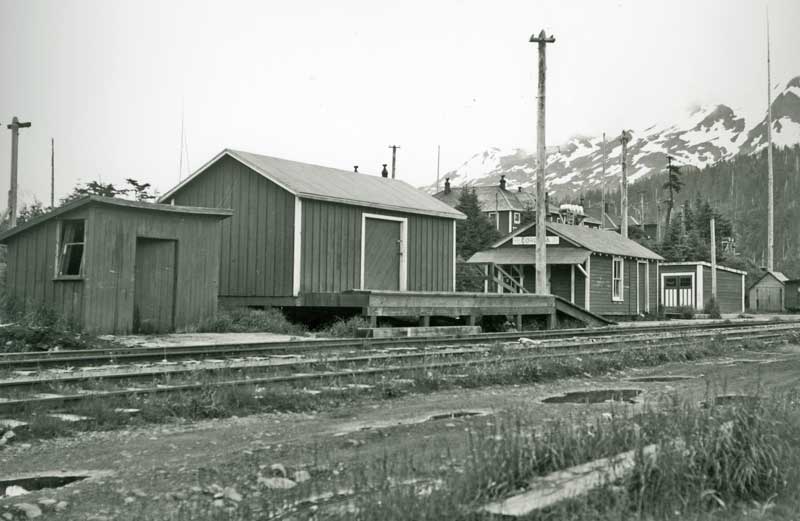 | ||||||||
Cordova depot area after RR abandonment --Cordova Museum | ||||||||
 | ||||||||
Below: A Miles & Childs Glacier excursion train leaves Cordova --Cordova Museum | ||||||||
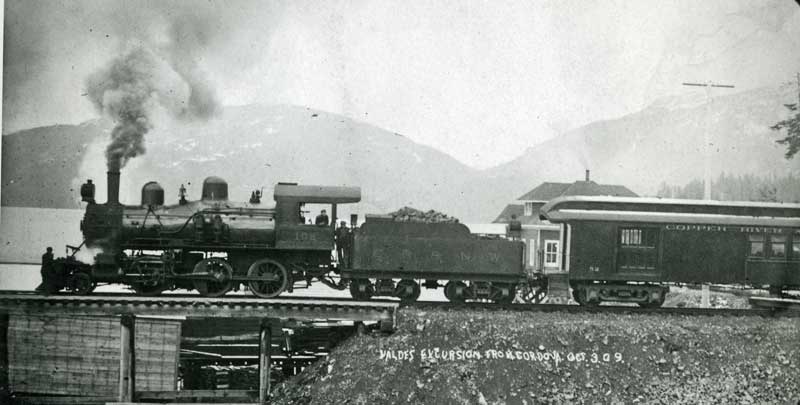 | ||||||||
Below: Cordova RR yard with the town site in distance: --Laurie Nyman collection | ||||||||
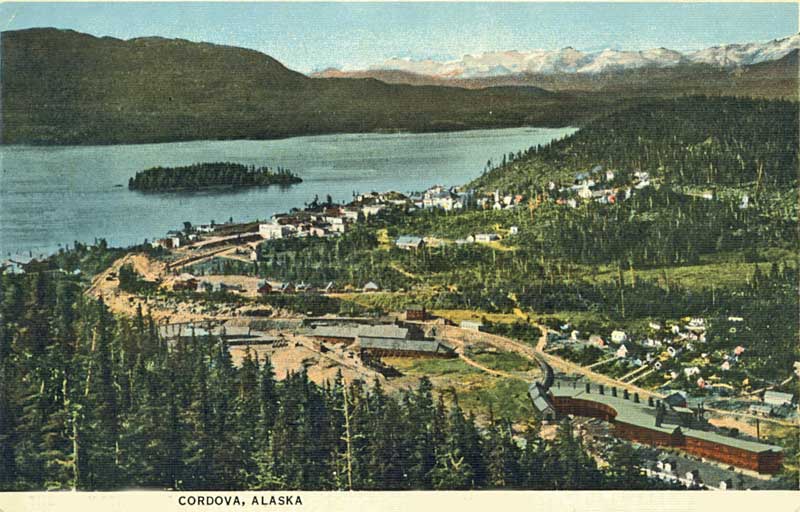 | ||||||||
The train left Cordova in an easterly direction, following a relatively flat glacial out-wash for the first twenty miles, crossing many small streams before it reached the foothills south of Sheridan Glacier. It followed along the hills until reaching the first crossing of the Copper River at Flag Point, CRNW mile 27. This was a complex bridge set-up, consisting of a series of wooden trestle approaches connecting nine narrow steel spans. The longest of these spans was 300 feet. This is the area of heavy winter winds that approached 100 miles per hour, causing snow drifts high enough to completely bury entire trains, as had happened in the past. The five days in Cordova were mostly sunny, as was this day. The ten mile-wide delta with its countless ducks and other birds seemed to extend almost forever in the glimmering rays which reflected back off the long expanses of partly-submerged lowlands covered with thick marsh weeds.
Once it crossed the bridges at CRNW mile 27, the train began heading north. It was far enough away from the shore to enable a good view of the southern edge of the Chugach Range. Then the train passed the steel bridges at Round Island, CRNW mile 34. These crossings consisted of a 200 foot span extending to a sand bar, then a wooden trestle which bridged the bar that extended to two more 200-foot steel spans. Now it was only a few miles to the Million Dollar Bridge.
Continue with "Mary and Stephen Birch Arrive at Childs Glacier" |
Ch 12, Pt 1: "Mary & Stephen Birch Arrive at Childs Glacier
Chapter 12, Pt 1: "Mary and Stephen Birch Arrive at Childs Glacier" | ||||||||
click on picture for larger image: these pictures are the one which appear in the book for this chapter. | ||||||||
Locomotive no. 74 was the fifth and last of the series of great engines of the Mikado class type purchased to upgrade Stephen’s ore train fleet. The CRNW had no 100-ton crane at the wharf, which was the minimum capacity needed to off-load the 95-ton locomotive. Tidal fluctuations at Cordova allowed an alternative means to deal with so large a piece of rolling stock cargo. The ship was kept in position until the tide lowered the reinforced deck to the same level as the dock. While the ocean level at the dock dropped the necessary twenty-two feet, the men installed rails from the engine to the edge of the ship on top of heavy planking. The engine was already sitting on rails bolted to planking. It had been loaded into place at Seattle using a large crane, which made the setting of the engine into place an unusually difficult feat. Yet there it sat, still heavily tied into place, still sitting comfortably on those seventy-five pound rails just as it had when it was so carefully dropped into place. The men ran temporary rails to the point on the dock where they would meet with the ship, running past the dock’s edge eight feet so that there would be no joint between the ship and the dock. The railroad workers joined the temporary rails at the critical moment when the tide level was perfect for the transfer. CRNW engines #70 thru 74 were the same series and were used primarily as ore-haulers By then, the tie-downs were removed and the engineer had the locomotive steamed up and ready to move. He stayed with the engine to ensure that the steam pressure and water levels remained just right for moving the massive locomotive under its own power. When the moment came, the men performed a final alignment of the rails and bolted them together. The foreman signaled the engineer and Dusty pull the reverse handle, allowing the engine to creep forward. The engine had been loaded so that it would point toward the dock, given the most likely way the ship would approach the wharf. The extremely heavy, self-powered load departed the ship with considerable creaking through the rails, the ship and the dock. The stevedores ensured that the ship could not dip because they had temporarily secured it tightly against the dock. It was imperative that the engine not tip at all. It left the ship smoothly. Stephen Birch and his party watched the entire procedure. He had asked the company to alert him when the tide was in the right position. His party arrived in a horse-drawn carriage owned by the hotel. The engine rolled onto the dock without a hitch to a loud round of applause. The loud whistle reverberated as the engine moved off to the eleven-bay roundhouse for a final check. Mogul No. 102 was the back-up assigned to Stephen’s private train. At eighty tons, it was considerably smaller than the Mikado which had just arrived. With its six large drive wheels, the engine could pull a small consist in excess of sixty miles per hour over most of the line. The mogul was ideal for Stephen’s private train, but it would not be used. Stephen wanted to use the newest and proudest, if an inanimate object could be described that way, of the great CRNW engines. He left no doubt to Superintendent Hansen that he wanted his private train headed by the mammoth No. 74. So it would be.
On the day the engine was ready, Stephen was at the turntable to watch No. 74 pull out of the bay onto the turntable. A worker started the powerful electric motor which swung the huge engine around until it was lined up with the exit rail. No. 74 blasted its whistle and rumbled off the wooden turntable deck. The crew linked a combination baggage and passenger car behind the tender and then added “The Kennecott” to the rear. All was ready for the train trip into the great interior over the “Route of the Marvelous Scenic Wonders.” In 1916 the CRNW was still the only standard gauge railroad entering interior Alaska, though the new Alaska Railroad would soon be operating a much larger line out of Seward to Ship Creek and beyond. The first passenger cars would travel the line from Seward to the new town of Anchorage in October. The government-built railroad would ultimately reach Fairbanks in mid-July, 1923--seven years after the Birch honeymoon trip. The choice of the government to build the railroad out of Seward instead of purchasing the existing CRNW and using the Cordova terminal guaranteed the end of the CRNW when the mining engineers declared Kennecott’s interior copper mines to be exhausted in 1938. Yet in the summer of 1916 it appeared that the CRNW was a permanent railroad which would last almost forever. In the few years since the railroad first opened its line to the Bonanza Mine the CRNW had filled in many of the long trestles which crossed the expansive Copper River delta with tens of thousands of cubic yards of gravel fill. Permanent steel bridges existed at CRNW mile 27, 34, 49 and 144. The railroad met high engineering standards and was considered a first-class system at least as far as CRNW mile 131, which was the Chitina depot. The consist left Cordova after five days instead of the two which Stephen had planned because Mary claimed to be too ill to travel. By the time Mary decided she was ready to travel, she was becoming quite unpopular with the rest of the party.
|
Subscribe to:
Comments (Atom)
